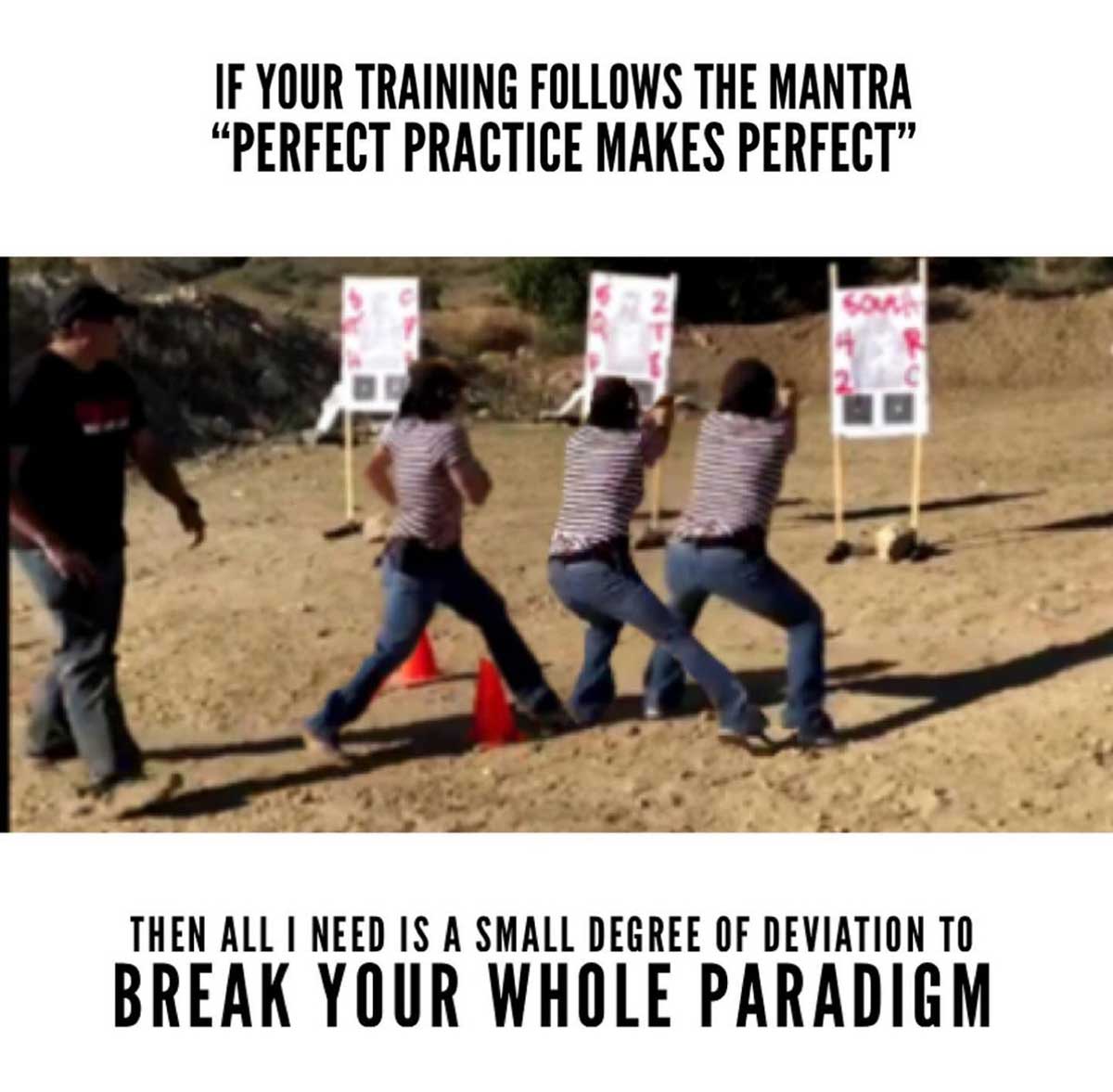
Photo: author
www.personaldefensenetwork.comMy name is Mike Dasargo, and today I want to share with you the Paradox of Perfect Practice. But first, this is how I arrived here. I used to be a disciple of the mantra “rehearsal to mastery.” From my teenage years through adulthood, I trained with former Chula Vista PD detective Tony Puyot in Chinese martial arts. If you’re unfamiliar with Asian martial arts, it’s an athletic culture that heavily emphasizes focus on movement quality and rehearsing technique to perfection. If you can’t punch well, it’s because you haven’t performed 10,000 reps. If you can’t fight, it’s because you haven’t drilled 10,000 times. As a hood rat living in South Bay San Diego, yeah, I had motivation to do 100,000 reps. And it paid off. Or so I thought.
When I started teaching martial arts, I studied kinesiology, sports psychology, athletic performance, and whatever modality I could find to best communicate and transfer knowledge to the students. I was able to develop students with outstanding technique. But when it came to pressure testing, it would all. fall. apart. I tried stress inoculation. Pressure testing. Ramping differing speeds. Modulating the frequency and magnitude of percussive impacts. Results were inconsistent at best.
Fast forward to 2013, when I was invited by Torin Hill to participate in the T.O.R.I.S. (Threat Oriented Rapid Incapacitation System) simulator designed to induce panic to test performance under stress. It’s a full sensory immersion to give you the perception of life-threatening danger, similar to the way that water boarding simulates drowning without actually drowning you. I did slightly better than average, and my behavioral conditioning from traditional martial arts gave all credit to my lineage. I discounted the idea that there’s anything special or unique about myself. A crucial albeit counterintuitive pivot happened in my perspective when Torin asserted that my statement was complete nonsense -- my success was entirely due to my unique experiential profile.
You see, I was raised in a violent environment, and the way my brain adapted to that experience facilitated my ability to train and condition certain responses with a higher-than-average degree due to my brain’s ability to interact with stimuli while under the influence of “survival serum”; a neurochemical spike in adrenaline, noradrenaline, dopamine, and acetylcholine. It had very little to do with 100k movement-focused repetitions and far more to do with how familiar I was with being under the influence of survival serum, and how much that experience was recalled during my practice.
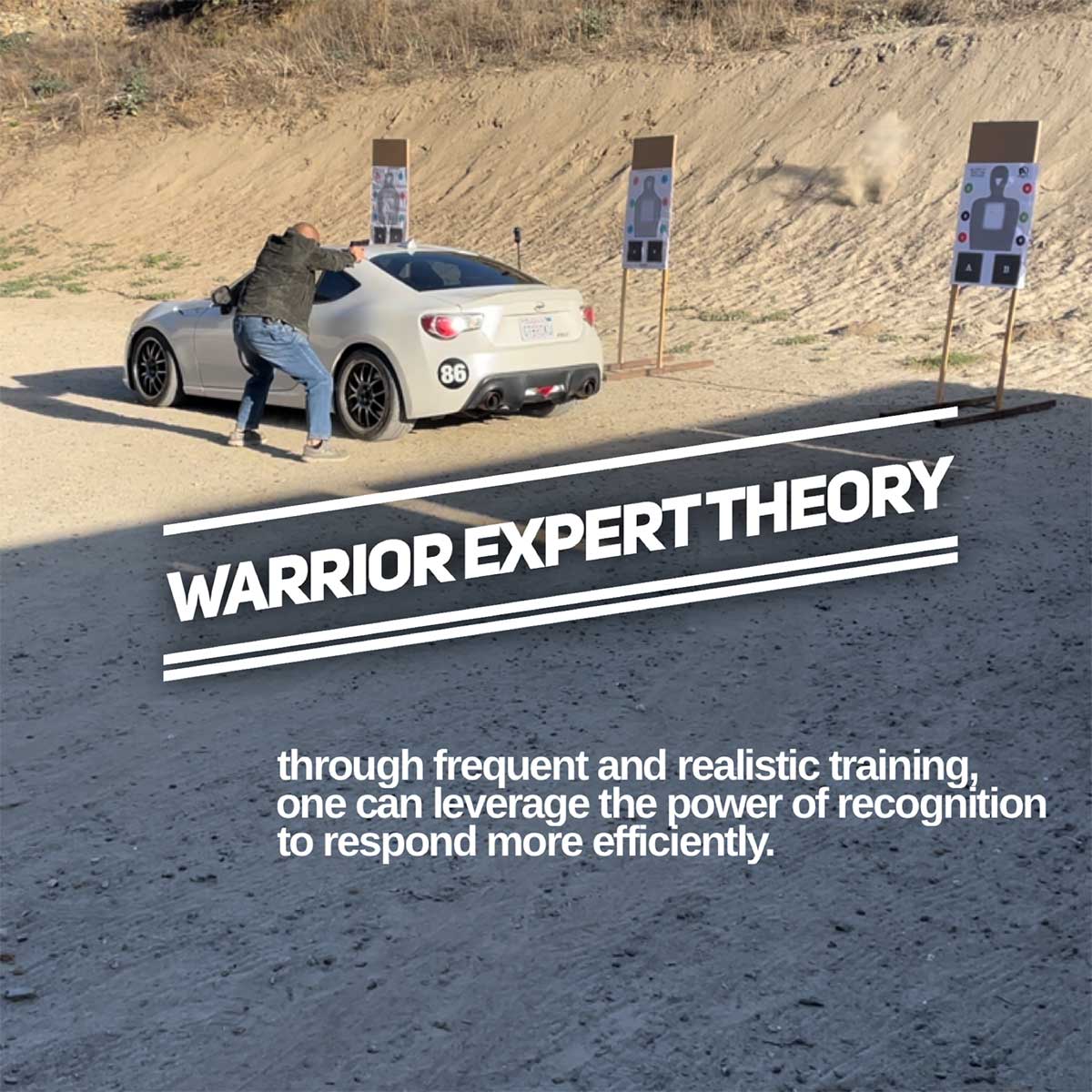
Training with as much contextual interference as is reasonably safe trains the mind and body to perform in a highly disruptive and unpredictable environment. Photo: author
www.personaldefensenetwork.comThat changed my whole outlook on training. And I finally began to understand what Rob Pincus has developed in the Intuitive Defensive Shooting program. I’d been going about the whole thing incorrectly, with chasing mechanical repetitions and trying to smash that in with some pressure testing and stress inoculation. Those pieces don’t fit together the way we want them to because the training modalities lack a significant piece, which is known as contextual interference.
In the pursuit of mastery, individuals often strive for perfection in their practice. It is commonly believed that perfect practice leads to better performance outcomes. However, recent research has shed light on a counterintuitive phenomenon known as the contextual interference effect. This effect challenges the notion that perfect practice always yields superior results, and instead suggests that a certain degree of variability and challenge is necessary for optimal skill acquisition and skill transfer. In this article, we will explore how perfect practice, devoid of contextual interference, can actually lead to poorer performance outcomes, and how performing poorly in practice as a result of unpredictable training demands results in robust skill transfer.
Defensive shooting is a critical skill that requires individuals to react swiftly and accurately in high-pressure situations. In this example, we explore an incident where an individual we’ll call Mason found himself in a defensive shooting situation. Additionally, we discuss how his training, specifically block practice, initially affected his performance negatively. We then delve into the concept of contextual interference and how it can significantly enhance training outcomes.
SCENARIO
One fateful evening, Mason, a responsible firearm owner, found himself facing a life-threatening situation. While Mason was walking through a dimly lit alley, a masked assailant suddenly appeared, shouting menacingly and brandishing a weapon. Fear gripped Mason, and he instinctively reacted and then reached for his concealed firearm.
ENCOUNTER WITH BLOCK PRACTICE
Mason had diligently attended firearms training courses, where they had practiced extensively with block training. In block training, participants repetitively perform a specific skill in a controlled setting, honing their technique. However, when it came to translating this training into real-life scenarios, Mason's performance suffered.
In the moment of crisis, Mason's mind tried to recall the simplistic block-training sessions: stance, grip, sight alignment, and trigger pull. Unfortunately, the intruder's unpredictable movements disrupted Mason's ability to execute these isolated skills efficiently. The surreal perception of moving in slow motion while the size of the assailant’s weapon was disproportionately large induced confusion and distracted Mason from paying attention to movement quality; something that was often hyper-focused on during training. Panic clouded his judgment.
THE CONCEPT OF CONTEXTUAL INTERFERENCE

The Emergency Reload optimizes the use of the visual and kinesthetic sensory systems by using your sense of feel in an automated reload while leveraging the visual systems to process the randomized visual indicators. Varied and randomized commands not only simulate defensive shooting scenarios, but also reveal which techniques are better suited for contextual interference. Photo: author
www.personaldefensenetwork.comContextual interference, on the other hand, focuses on practicing skills in varied and unpredictable situations. Instead of drilling the same sequence of actions repeatedly, it involves introducing random or interleaved practice scenarios. By forcing the brain to continuously adapt and make split-second decisions, contextual interference replicates the chaos of real-life situations. Throw in the reality of the body’s natural reactions under traumatic stress, and you’ll reach a level of preparedness not made available in choreographed and predictable training environments that lack emotional context. The body’s natural reactions are a fundamental premise that drives the technique selection found within the Intuitive Defensive Shooting and USCCA Defensive Shooting Fundamentals programs.
UNDERSTANDING PRACTICE AND SKILL ACQUISITION
Practice is the cornerstone of skill acquisition, as it allows individuals to refine their abilities and improve performance over time. However, not all practice is created equal. Variability and challenge play crucial roles in enhancing the learning process.
CONTEXTUAL INTERFERENCE AND SKILL ACQUISITION
Contextual interference relates to the interference caused by practicing multiple skills or variations of the same skill in a mixed and unpredictable manner. A high level of contextual interference poses challenges to learners, forcing them to adapt and problem-solve in real time. This type of practice creates a desirable level of cognitive demand, promoting long-term retention and transfer of skills to complex settings.
BLOCK PRACTICE: THE TRADITIONAL APPROACH
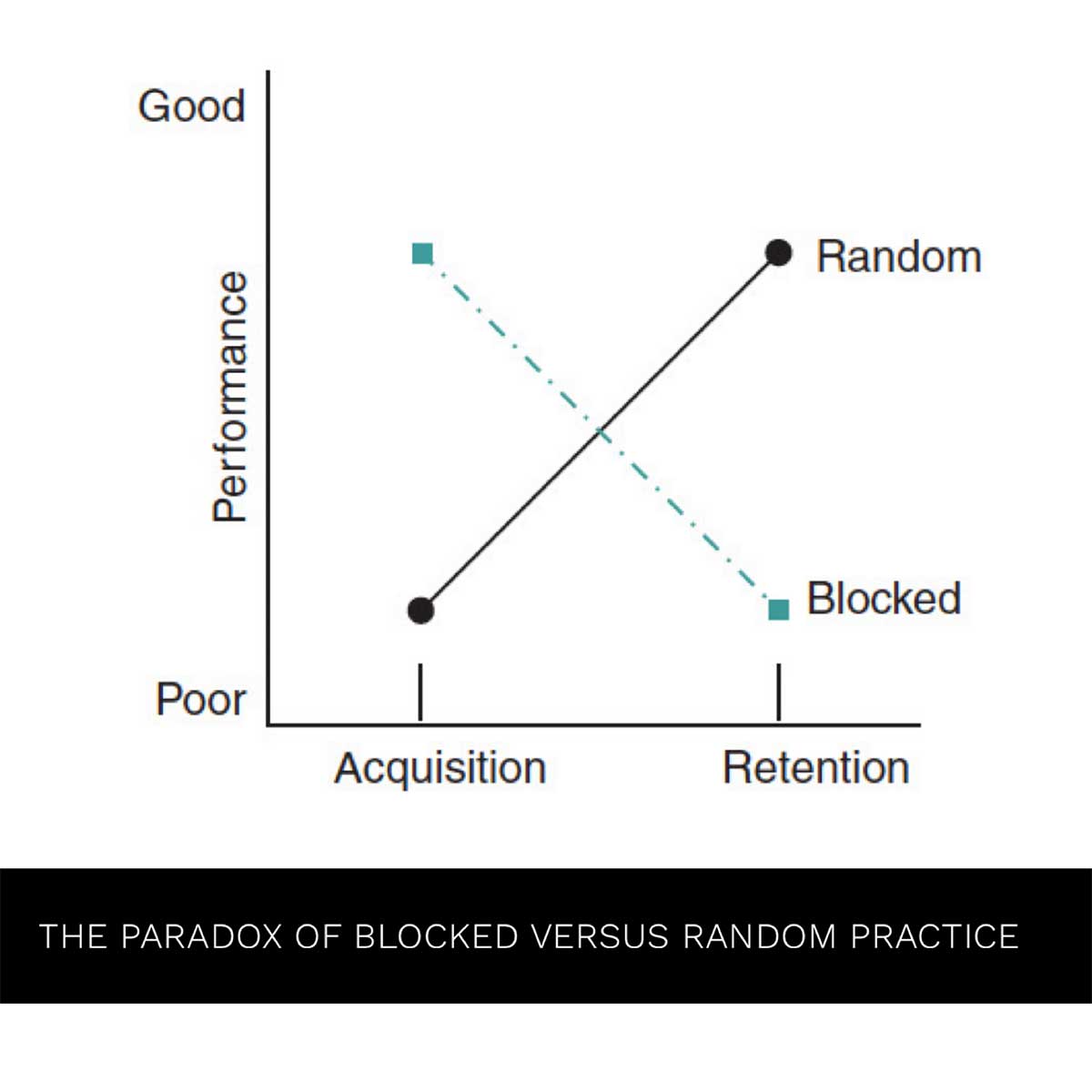
"The paradox arises from the fact that blocked practice is in fact very ineffective for transfer of learning to competition as performance improvements measured during practice degrade rapidly, and are inefficient because retraining on the same skills will be necessary." Motor Learning Principles and the Superiority of Whole Training in Volleyball, Steven Bain, Ph.D., and Carl McGown, Ph.D. Image: author
www.personaldefensenetwork.comBlock practice, which entails repetitive drills focusing on a single skill or a limited set of variations, has long been the conventional training method in many sports. In the context of defensive shooting, this could involve practicing shooting targets from a fixed distance and shooting a predetermined number of rounds without distractions. Block practice allows the learner to concentrate on perfecting a specific technique and focus exclusively on movement quality, thus facilitating initial skill acquisition. There is value in training this way if the skill requires complex movement sequences, or if the dangers of adding more things to think about outweigh the benefit. However, for a vast majority of defensive shooting skill development, it may not effectively promote the transfer and retention of skills in dynamic and high-pressure scenarios.
One of the primary drawbacks of block practice is the resulting overfamiliarity with a fixed set of conditions. In defensive shooting scenarios, real-life situations are often unpredictable and non-repetitive. Consequently, solely practicing under block conditions fails to adequately prepare individuals for the complexities of these dynamic scenarios. In a high-stress situation, relying solely on memorized sequences obtained through block practice can lead to cognitive rigidity, inhibiting effective decision-making and adaptation. Take, for example, the double-tap. Habituating the double-tap arbitrarily disrupts the string of fire that may not have resulted in a stop. Instead, students should vary their string of fire from three to seven rounds and visualize a change of behavior as a result of their actions.
Additionally, block practice tends to promote a technique-based mindset, where the focus is primarily on executing the assigned technical task correctly. While precision is essential in defensive shooting, it is equally vital to develop the ability to adapt to unforeseen variables. In real-life scenarios, the conditions, distances, and targets may vary significantly. Without exposure to a range of these factors during training, defensive shooting skills remain limited and less effective.

Block practice may be useful in identifying psychological limiters of performance. In the Push Your Limits drill from Intuitive Defensive Shooting, the string of fire cadence and subsequent shot placements reveal whether a shooter’s speed limit is psychological or mechanical. Photo: author
www.personaldefensenetwork.comWhen practicing in a blocked manner, where the same skill is repeatedly practiced before moving on to another skill, performance during practice tends to be high. This is because learners become proficient at executing a specific skill with minimal distractions or disruptors, allowing for seemingly flawless execution. However, when it comes to developing defensive shooting skills, block practice alone possesses inherent flaws that hinder the acquisition of robust and adaptable abilities. To overcome these limitations, incorporating the mechanisms of randomization, variation, and contextual interference becomes crucial.
RANDOM PRACTICE: EMBRACING CONTEXTUAL INTERFERENCE
In contrast to block practice, random practice incorporates a more varied and unpredictable training environment. The Intuitive Defensive Shooting program, developed by Rob Pincus, has been leveraging contextual interference since its inception in the early 2000s. It introduces different shooting scenarios, target types, distances, and orientation to the target, simulating real-life defensive shooting situations. This practice approach challenges the learner to quickly assess and adapt to the context they encounter. Random practice enhances the ability to handle the unexpected, make decisions under pressure, and effectively apply defensive shooting skills when it matters most.
BENEFITS OF RANDOM PRACTICE IN DEFENSIVE SHOOTING SKILLS
1. Cognitive Flexibility: Random practice promotes cognitive flexibility by requiring shooters to constantly adjust their shooting schemes and decision-making processes. This skill translates to real-life scenarios where self-defense situations often demand rapid assessment and response. The way Assessments and Multiple Target Engagements (MTE) are taught in the Intuitive Defensive Shooting program is the perfect training exercise for breaking fixation on the first threat that has been stopped, and working with the effects of tunnel vision to assess the environment. MTE is practiced with a focus on the cognitive strain that results from observing the environment and actively assessing the surroundings for relevant cues. The true value of MTE is the effort of the brain, rather than the expediency of shooting. Training in this way is a closer simulation of a chaotic environment where there is a high probability of fixation on the first threat, with unknown variables including other CCW carriers, security, arriving law enforcement, and more that can jeopardize the defensive shooter’s safety.
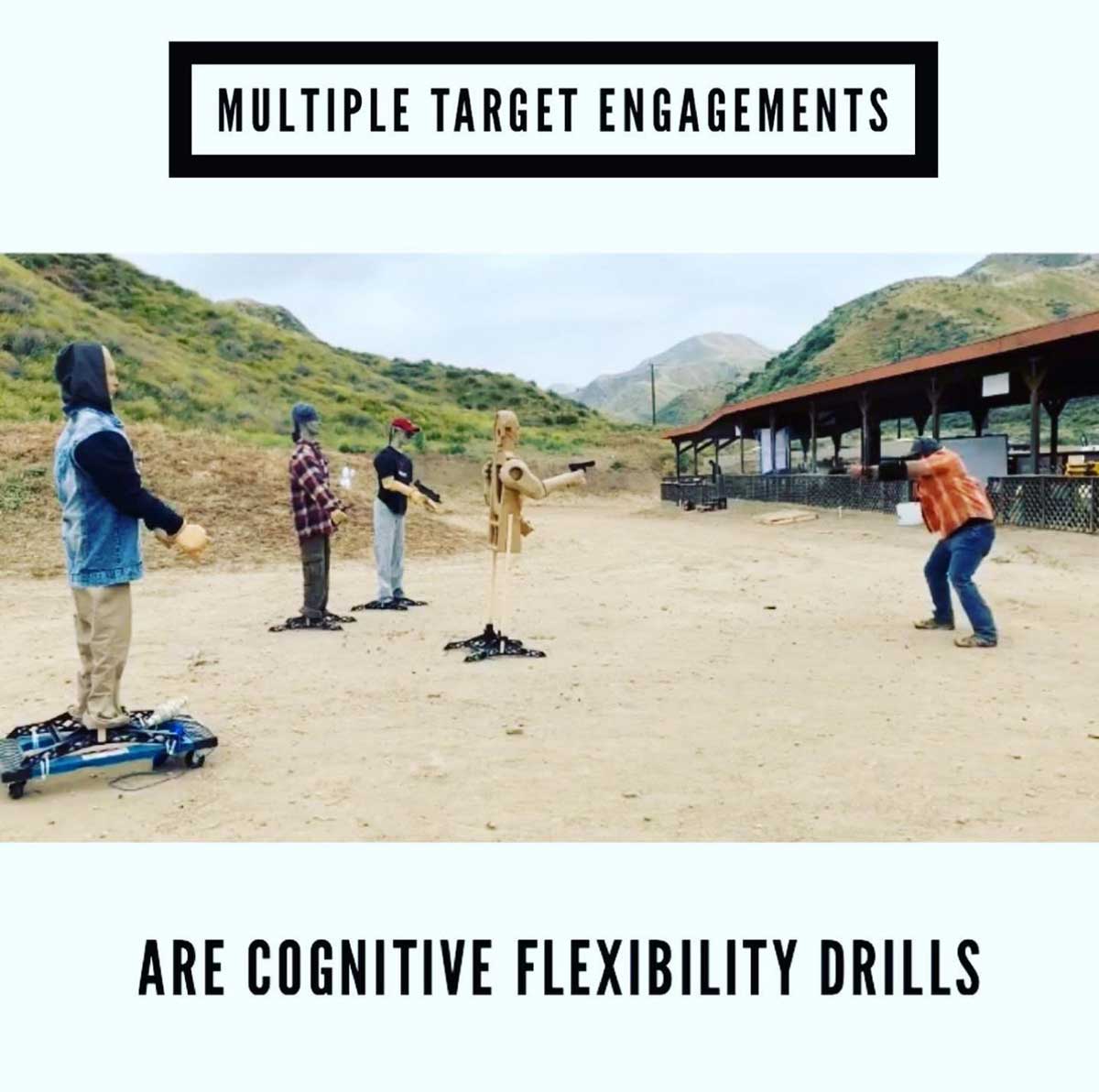
Photo: author
www.personaldefensenetwork.com2. Retention: Studies have shown that random practice leads to better long-term skill retention as compared to block practice. When training sessions replicate real-world situations, learners develop a wider repertoire of defensive shooting techniques that can be seamlessly recalled and effectively applied when needed. Varying target size, distance, and orientation develops the skill to fluctuate shooting speed and cadence to adequately control the cone of fire for an unexpected precision demand.
3. Transfer of Learning: The varied conditions in random practice facilitate the transfer of learning, enabling the application of skills across a range of situations. This approach enhances adaptability, ensuring that defensive shooting skills remain effective in different scenarios, from home defense to active shooter situations.
The mechanisms of randomization, variation, and contextual interference hold the key to overcoming the inherent flaws of block practice. Randomization involves introducing elements of unpredictability into training sessions. By incorporating random timing, target placement, and shooting sequences, practitioners are forced to develop "on-the-spot" decision-making skills and adapt their techniques accordingly. This randomness helps build resilience and prepares individuals for the unpredictable nature of defensive shooting scenarios.
ROLE OF CONTEXTUAL INTERFERENCE
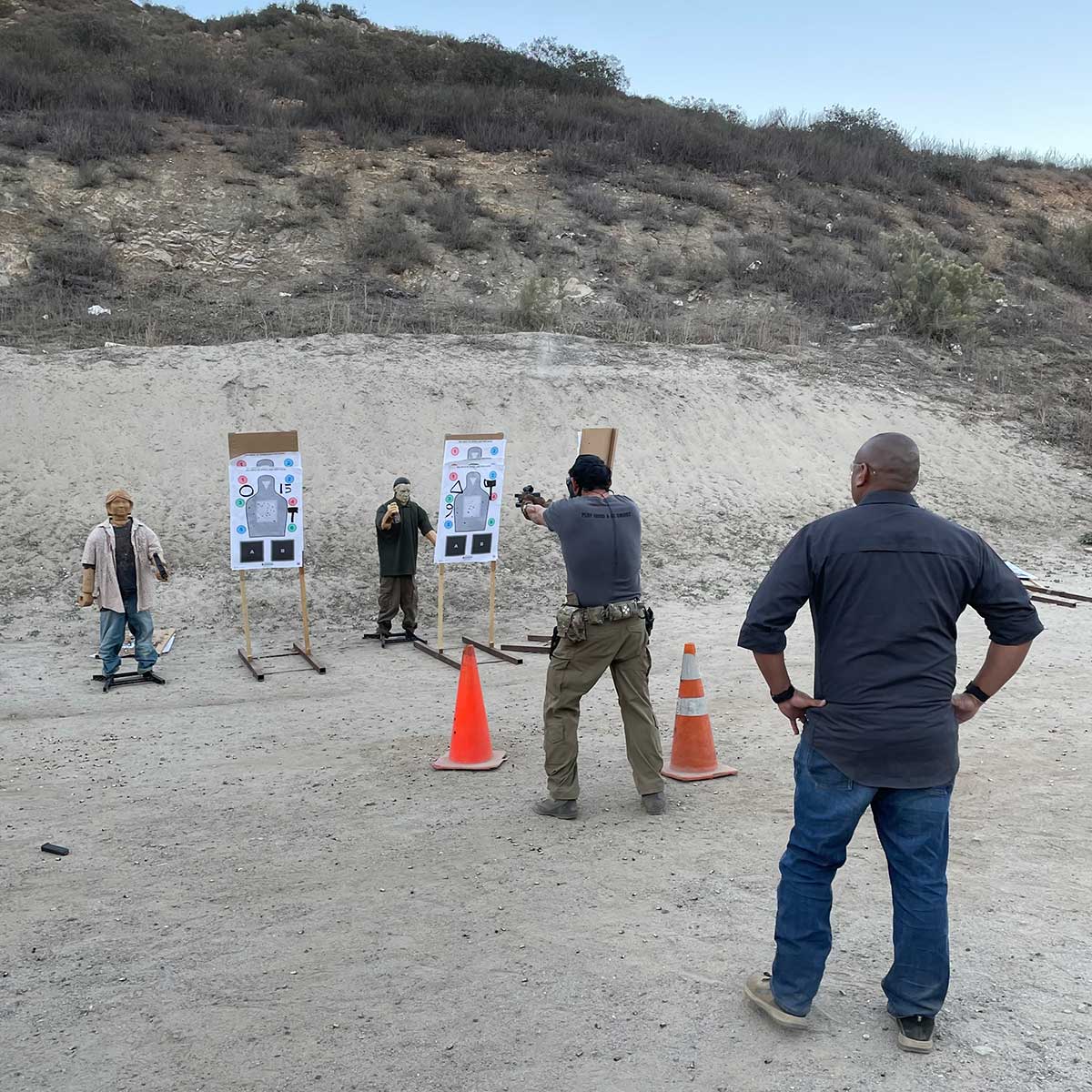
Strain is the pathway to growth. When it comes to defensive shooting, the randomized threat indicators place a cognitive load on the brain and subsequently diminish the peak performance often demonstrated when thoughts can be focused exclusively on movement quality. Although performance suffers in practice, the context-induced strain, affectionately referred to as "the struggle bus," results in deeper learning, better retention, and better performance in context. Photo: author
www.personaldefensenetwork.comContextual interference occurs when practice is structured in an interleaved or random manner, forcing learners to repeatedly switch between different tasks or skills. This approach leads to a struggle with performance during practice, as learners grapple with varied demands and contexts. Paradoxically, this challenging practice method cultivates better retention and transfer of skills to real-world situations. The process of recalling, adapting, and applying skills under different conditions enhances long-term learning, despite short-term performance difficulties.
BENEFITS OF CONTEXTUAL INTERFERENCE
1. Promotes Deep Learning: Contextual interference encourages learners to engage in deeper cognitive processing. By frequently switching between tasks, learners must constantly adapt to new situations, leading to a more comprehensive understanding of the skill.
2. Enhances Long-Term Retention: Repeated exposure to varied practice conditions strengthens memory encoding and retrieval processes, resulting in improved retention of skills over time.
3. Transfers Skills to Real-World Contexts: Practice that closely mimics real-world environments fosters the transfer of skills to diverse situations. The ability to generalize acquired skills is crucial for successful performance in practical settings.
4. Builds Robustness and Flexibility: Practicing under challenging conditions promotes flexibility, adaptability, and resilience. These qualities enable individuals to perform well in unpredictable and dynamic environments.
HOW DOES CONTEXTUAL INTERFERENCE WORK?
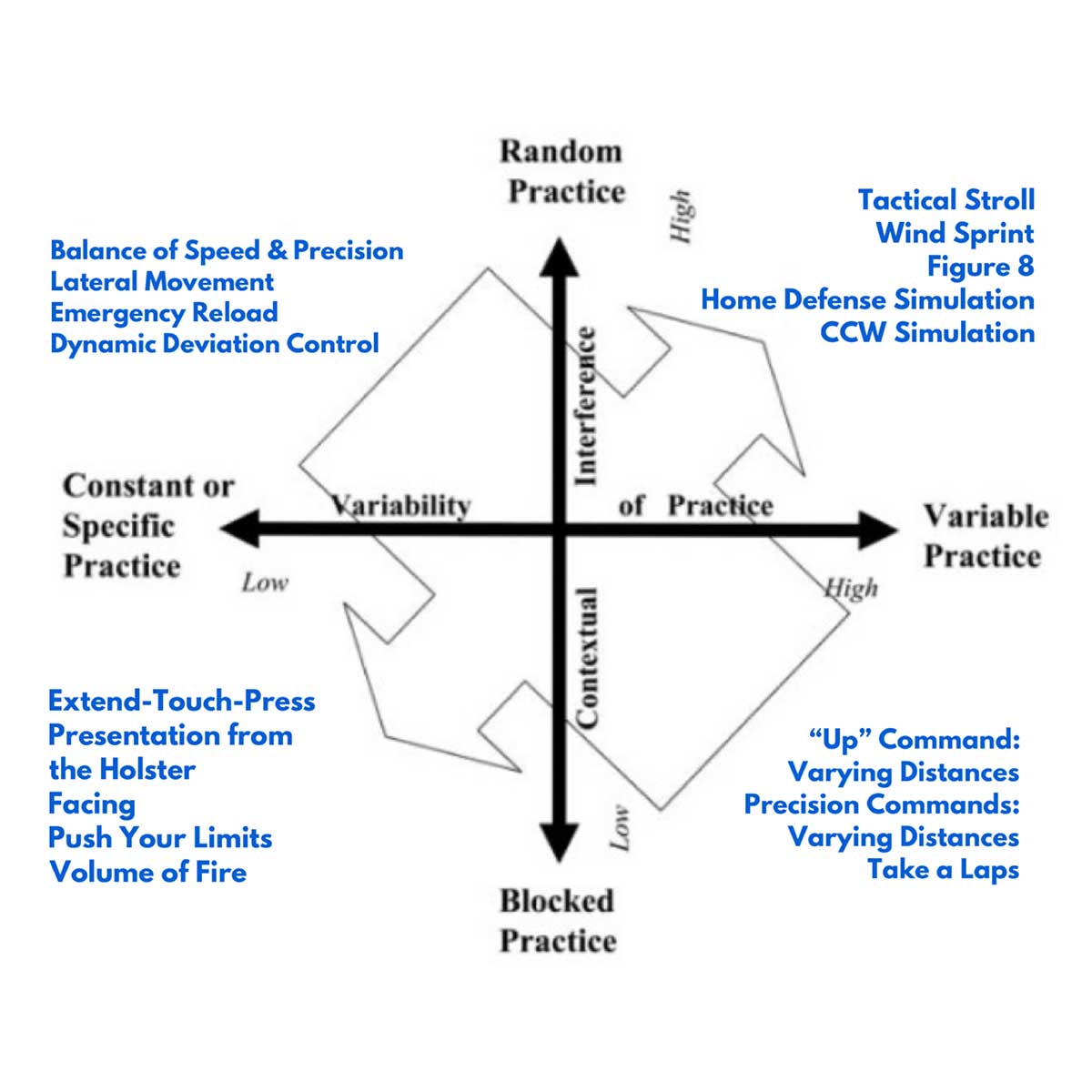
Techniques should be developed and tested with as much contextual interference and variable parameters as permitted by the safety and complexity of the drill. This chart illustrates how the Intuitive Defensive Shooting program includes fixed and predictable starting points yet quickly progresses to increasingly random and varied practice. Image: author
www.personaldefensenetwork.comThere are two main hypotheses pertaining to why contextual interference yields better performance outcomes: the “forgetting-reconstruction” and “elaborative processing” hypotheses.
FORGETTING-RECONSTRUCTION
At its core, the forgetting-reconstruction hypothesis suggests that when individuals encounter disruptions or discrepancies in their planned actions, they engage in a dynamic process of cognitive reconstruction. This reconstruction involves the evaluation and revision of their original action plans to better align with the new circumstances. Put simply, the process is see-plan-do-forget-plan-do.
First and foremost, individuals need to perceive and recognize the disruption or discrepancy, allowing them to shift their attention from executing the original plan to reassessing the situation. This initial step is crucial because it alerts individuals to the need for plan reconstruction.
Once aware of the disruption, individuals engage in a mental process known as "planning with interruption." They evaluate the impact of the disruption on their original plans, considering factors such as feasibility, effectiveness, and efficiency. During this stage, individuals may generate alternative action sequences, anticipate potential obstacles, or brainstorm new strategies that better accommodate the current circumstances.
Individuals need to assess the appropriateness and effectiveness of their actions in real time, making adjustments and adaptations as necessary. This ongoing monitoring helps individuals remain flexible and responsive to any further disruptions or unexpected changes that may arise.

Photo: author
www.personaldefensenetwork.comAn example of see-plan-do-forget-plan-do that happens frequently is shooting around vehicles. We often favor a specific shooting stance and want to stand in a conventional weak-foot-forward fighting stance, but the rapidly changing shooting angles and random use of vehicular cover or concealment makes us abort what we wanted to do and quickly improvise our body posture to reduce exposure while facilitating a stable platform with consistent shooting fundamentals. Although our posture may become off-balance in the chaos, the shooting structure of the wrists, elbows, and shoulders can remain stable enough to get the hits we need to get. That’s why in the Intuitive Defensive Shooting program, we say that stance is a matter of convenience. Additionally, the see-plan-do-forget-plan-do observation in performance is evidence for why we should strive for good enough rather than technical perfection.
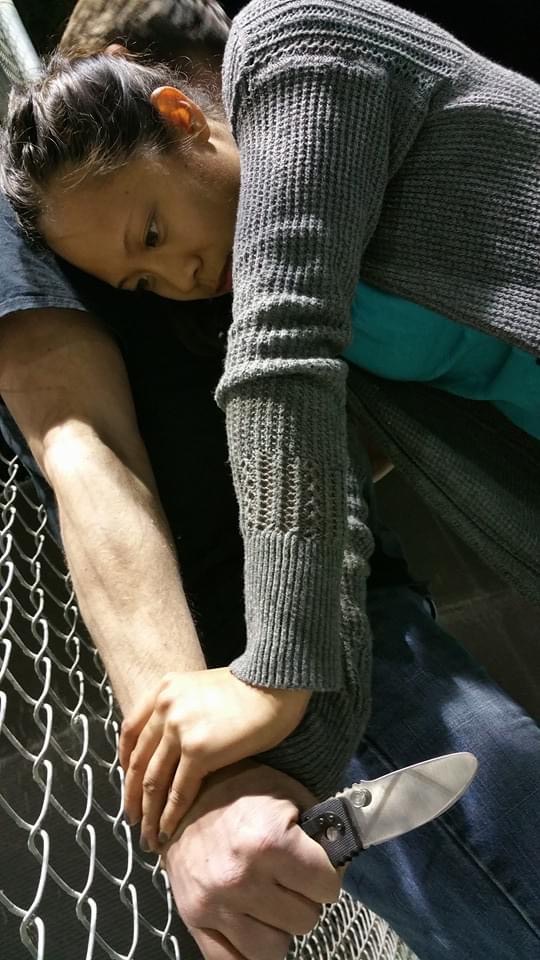
Photo: author
www.personaldefensenetwork.comAnother example is: You are threatened with a knife by a person who is inside two arms’ reach, creating a risk of your getting cut or stabbed if you go to your gun, so you decide to lunge in to control the knife first. But in the process of holding the threat’s wrist, he rotates away before you can establish a body clinch and pulls his wrist free of your grip to a space just beyond one arm’s reach. Aborting the initial action plan to control the knife and adhering to the principles of maintaining separation, your plan reconstructs to turn your hips and run to maintain space while accessing your firearm and presenting the gun toward full extension to effect high-center-chest hits.
Creating space outside two arms’ reach reduces the risk of being harmed by the contact threat, but does not stop the attack in progress. There’s no guarantee that athleticism will result in a psychological stop for the attacker (attacker quits attacking). In that moment of separation when the attack is in progress, the need to stop the threat/attack is still very high and will likely remain high until there’s an observed change in behavior.
The forgetting-reconstruction hypothesis trains your brain to let go of what you wanted to work (controlling the knife) and quickly formulate better solutions (creating space). It helps you get better at working with what you have rather than depending on the conditions you wanted.
The defensive shooting around vehicles example illustrates how see-plan-do-forget-plan-do cycles within an intended technique. The knife control illustrates how see-plan-do-forget-plan-do cycles within a response. Both require significant cognitive flexibility that can only be exercised and developed by the random and spontaneous nature of contextual interference.
ELABORATIVE PROCESSING

Photo: author
www.personaldefensenetwork.comAccording to the elaborative processing hypothesis, the more extensively information is processed, the better it is remembered. In other words, the depth of processing plays a crucial role in determining the strength and accessibility of memory traces. Rather than simply storing information passively, individuals actively engage in elaborative processing, which involves relating new information to existing knowledge and creating meaningful connections.
Elaborative processing occurs on a continuum, ranging from shallow to deep levels of processing. Shallow processing involves superficial encoding that primarily focuses on the physical characteristics of stimuli, such as their appearance or sound. For example, a person may remember a phone number by repeating it multiple times without paying attention to its meaning or context.
On the other hand, deep processing involves semantic elaboration, which requires individuals to engage in meaningful thinking and relate new information to their previous knowledge. This type of processing involves a deeper analysis of the meaning, significance, and relevance of information. For instance, remembering a phone number by associating it with a special date or event makes the encoding process more meaningful and increases the likelihood of retention.
Let’s take shooting a simple string of fire. This skill is fundamentally about stance, grip, trigger pull, and recoil management. To elaborate on a string of fire in context, progressively stack the skills of presenting from the holster, moving laterally, and varying the distance of the target from near to far, changing the aiming focus from front sight to threat focused. Stacking the skills practiced elaborates the skill from isolation to holistic context, providing deeper understanding and skill recall when you need to perform.
CONCLUSION

Visualization is known to improve motor performance. Contextual sensory simulation further immerses you in the experience of defensive shooting. In the Defensive Shooting Fundamentals program, students experience a sensory holodeck by simulating interacting with friends and family before an imminent threat presents. Fully immersing into the simulation induces the emotional context of defensive shooting, a variable that is both understated and undertrained. Photo: author
www.personaldefensenetwork.comWhile the pursuit of perfection is commendable, research suggests that perfect practice devoid of contextual interference may not yield the desired performance outcomes. A reduction of block practice with progressive contextual interference load is essential for optimal skill acquisition. Incorporating variability and challenge into practice sessions through interleaved or random practice methods can enhance long-term learning, retention, and transfer of skills. By embracing the contextual interference effect, individuals can overcome the paradox of perfect practice and achieve better performance in real-world contexts.
PROLOGUE: PART 2
Sprinkled in this article are hints concerning the significant impact emotional valence has on performance. Emotional valence is a critical yet under-leveraged aspect of contextual interference. Defensive shooting induces a wide range of emotions, including fear, anxiety, anger, and adrenaline. These emotional responses are natural and can have both positive and negative effects on one's performance. Emotional valence refers to the overall positive or negative nature of these emotions and their impact on decision-making and actions during a defensive shooting incident. In my next article, I’ll do a deep dive into how emotional valence impacts defensive shooting performance, and how well shooters process emotion may be as important as how well they process information.

Great read - so what is the solution? HOW do I incorporate this randomness and cognitive variability into my day to day training as an armed citizen?
Very good reading with practical insight to training that should evolve with the changing times.
Very interesting stuff Michael! I would love to read more of the research you sited in your article. You mentioned a few times "recent research" and "research suggests". Next time it would be super helpful if you could link to the research or include the links in a footnote. The images/charts you created here are also really good for visual learners like me. I wish they were clickable so I could enlarge them to see them more clearly rather than having to save off the images to zoom in. Otherwise, great work! I will definitely share with my students.
Great info and insight sir!
I found this article to be very informative and packed with useful information. Thank you for providing great content!
Great article, good reminder to not only pursue training but proper training that incorporates real life scenarios and considers the chaos that usually ensues with such encounters.
Great article. I need to try the TORIS simulater lol
There are a number of disciplines that use really sound medical, psychological and pedagogical information to optimize training g. It’s just terrific to see this in the personal defense world for civilians. This approach gives lie to the assumption of many that any gun user is barely evolved beyond Cro Magnon man. The whole article and the approach it endorses is just really, REALLY good stuff. More, please!
Most of the information in this article, in bits and pieces, large and small, I’ve seen or heard before. Your presentation just took all that random content and in ten minutes consolidated the concept that just “clicked “ for me. And yes, I’ll never be a rocket scientist. Looking forward to your next article!
One of the best articles I’ve read in a long time! The examples and scenarios really helped with interpretation of the technical aspects of the article. Appreciate this whole knew aspect of defense training.